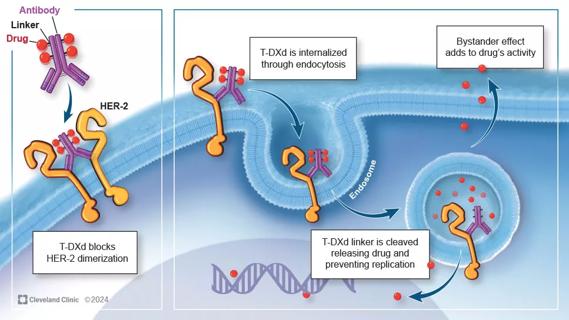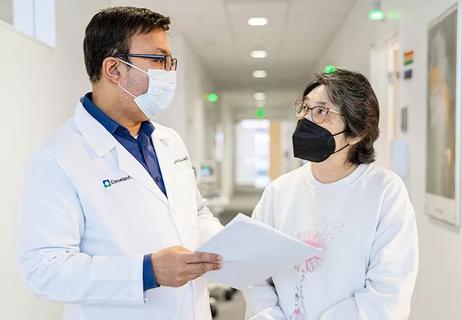After making leading-edge genetic discoveries that reveal how myeloid leukemias and myelodysplastic syndrome acquire specific genetic mutations that can help predict their clinical behavior, researchers at Cleveland Clinic’s Taussig Cancer Institute are working to translate these findings into treatments.
Cleveland Clinic is a non-profit academic medical center. Advertising on our site helps support our mission. We do not endorse non-Cleveland Clinic products or services. Policy
They are moving from a discovery phase into clinical application and innovative diagnostic, individualized therapies.
“We are at the forefront with new, incredibly efficient genomic technologies that exponentially increase our ability to characterize genomic defects leading to leukemia,” says Jaroslaw Maciejewski, MD, PhD, Chairman of the Department of Translational Hematology and Oncology Research.
“Our team has discovered multiple new mutations, including those in the SETBP1 gene, which frequently mutate in a subset of leukemias. Now we are moving into the clinical application of these technologies to generate comprehensive testing panels for the most commonly occurring mutations.”
Dr. Maciejewski says SETBP1 mutations hold great promise as a novel therapeutic target. SETBP1 mutations ramp up the evolution of myeloid leukemia.
Conceptually, development of a drug to turn off or silence an overactive gene mutation is easier than devising a strategy to turn on an essential gene switched off or damaged by a cancer.
“We’ve discovered a very important mutation, a somatic mutation, in a subset of leukemia patients that can be targeted with drugs,” says Dr. Maciejewski, who is also Professor of Medicine at Cleveland Clinic Lerner College of Medicine.
The implications go beyond identification of specific mutations to aid the approximately 10 percent of leukemia or myelodysplastic syndrome patients who carry SETBP1 mutations. These innovations coming out of Cleveland Clinic will usher in a new era of individualized medicine for patients fighting these cancers. “That’s the big picture,” Dr. Maciejewski says.
The genetic profile of individual lesions can help clinicians identify which patients are likely or unlikely to respond to individualized therapy.
“Many of the drugs we have now work very well but they are not very targeted, so we don’t know who will respond,” Dr. Maciejewski says. “By targeting therapy to a specific genomic lesion, we avoid potentially toxic and futile therapies for patients who do not have the lesion and we maximize response among those who do.”
Without such knowledge, administration of an agent that effectively shuts down the SETBP1 mutation and its promotion of cancer progression would work in only about 10 percent of leukemia patients. Dr. Maciejewski says, “But if you only treat the 10 percent of patients who have the mutations, your response rate in this subgroup of patients will be very, very high. Thus, we can provide effective therapy to a subset of patients while working on drugs for the next variant of leukemia.”
Discovery of the surprising role of SETBP1 somatic mutations in fostering leukemias and myelodysplastic disease is the latest in a series of important advances to emerge from Cleveland Clinic. The findings were simultaneously published in two studies by Dr. Maciejewski and colleagues in the August 2013 issue of Nature Genetics.
The studies outline the promise of SETBP1 findings for a subset of adults fighting these cancers and for children combating chronic juvenile myelomonocytic leukemia.
All these advances in understanding the genetic framework of myeloid leukemias and myelodysplastic syndrome are due to rapid developments in next-generation genetic sequencing and high-throughput genetic arrays. These technologies have led to a realization and appreciation of the great diversity of these cancers.
“These mutations, or combinations of these mutations, are individual to each patient,” Dr. Maciejewski says.
Previously, SETBP1 mutations primarily were associated with Schinzel-Giedion syndrome. Notably, children with this rare congenital condition and its characteristic physical malformations inherit the genetic abnormality. In contrast, the new discoveries at Cleveland Clinic show that the SETBP1 mutations are acquired during the cancer development process.
“These research findings exemplify our Cancer Institute’s strengths. We are at the forefront of driving discoveries with this set of diseases, and we hope to translate these discoveries into the development of individualized therapies,” Dr. Maciejewski says.
Photo credit: © Russell Lee

First-of-its-kind research investigates the viability of standard screening to reduce the burden of late-stage cancer diagnoses

Study demonstrates ability to reduce patients’ reliance on phlebotomies to stabilize hematocrit levels

Findings highlight an association between obesity and an increased incidence of moderate-severe disease

Cleveland Clinic Cancer Institute takes multi-faceted approach to increasing clinical trial access

Key learnings from DESTINY trials

Gene editing technology offers promise for treating multiple myeloma and other hematologic malignancies, as well as solid tumors

Study of 401,576 patients reveals differences in cancer burdens as well as overall survival

Enfortumab plus pembrolizumab reduced risk of death by 53% compared with platinum-based chemotherapy